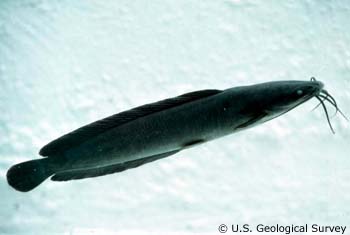
Clarias batrachus
This long, dark fish has lung-like organs and a high tolerance to harsh living conditions, and it can leave the water to walk/wiggle to a better location as long as it stays moist. Although it is native to Southeast Asia, it has successfully invaded other areas with the help of humans, including eastern India, Pakistan, the Philippines, and South Florida. Because of their mobility and tolerance, and their indiscriminate feeding habits, they have been labeled an aggressively invasive species and blacklisted in several countries, including the US.
Order – Siluriformes
Family – Clariidae
Genus – Clarias
Species – batrachus
Common Names
Walking catfish is the most common English name for this species. The Thai name Pla duk dam translates to “dull colored wriggling-fish”. Other English language common names include clarias catfish, freshwater catfish, thai hito (Thai), and Thailand catfish. alimudan (Visayan), hito (Tagalog), hitong batukan (Tagalog), ikan keling (Malay), ito (Kapampangan), kawatsi (Kuyunon), keli (Malay), klarievyi som (Russian), konnamonni (Finnish), leleh (Javanese), magur (Bengali), nga-khoo (Burmese), paltat (Ilokano), pla duk nam jued (Thai), trey andaing roueng (Khmer), and wanderwels (German) are common names used in countries other than the U.S.
Importance to Humans
Within areas of its native range, the walking catfish is valued as a food fish and is the focus of both subsistence fishers and commercial farming operations. Owing to its ability to survive extended periods out of water, walking catfish can be sold and traded live with ease, ensuring a fairly fresh food product. Outside of its native range, the walking catfish is a demonstrated pest, with the potential to do severe ecological and economic harm. In response, numerous countries have “blacklisted” the walking catfish, including the United States, which has classified all members of the family Clariidae as injurious wildlife, illegal to possess without a federal permit

For a clear demonstration of the walking catfish’s ability to invade and alter new habitats one need look no further than Florida, USA. The origins of the well-known population of walking catfish thriving in South Florida today date to the early 1960’s and are well documented. The initial introduction is believed to be linked either to the importation of adult brood stock by an aquaculture facility in Palm Beach County or to a truck transporting brood fishes between Miami and the town of Parkland, Broward County, Florida. The spread of the walking catfish from this zone of introduction has been nothing short of remarkable. Finding the many hundreds of miles of interconnected canals in south Florida to be a veritable highway for dispersal, this species spread to 20 counties in 10 years, no doubt aided by its ability to traverse short distances over land and potentially enhanced survivorship imparted by parental care of their young.
Besides colonizing a vast area, walking catfish have achieved extraordinary levels of abundance in certain areas of South Florida as well. Analysis by one researcher noted levels of abundance as great as 3,000 pounds of walking catfish per acre.
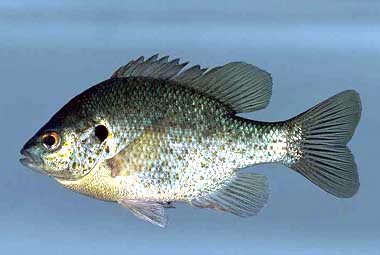
Since the explosive initial spread of this species in Florida, its dispersal northward has slowed. Studies have shown that the lower lethal temperature for walking catfish is 9.4 – 12.8° C, depending upon the “thermal history” of individual fish. Although such a lower limit would seem to eliminate further northward colonization, concern remains that the species could find refugia in the form of the many warm springs of north central Florida and survive short cold spells through its habit of burrowing into the mud during periods of low temperature.
Given the source of the South Florida population it is ironic that one of the most clearly demonstrated negative effects of walking catfish in the region is their propensity to invade commercial aquaculture facilities, often consuming vast numbers of the stocks of fishes therein.
Conservation
The walking catfish’s ability to withstand marginalized and altered habitats likely precludes any significant decline in this species within its native range or elsewhere. In areas where it has been introduced, the walking catfish is thought certain to pose a threat to native fishes and aquatic environments although relatively little quantitative evidence has been published to date.
> Check the status of the walking catfish at the IUCN website.
Geographical Distribution
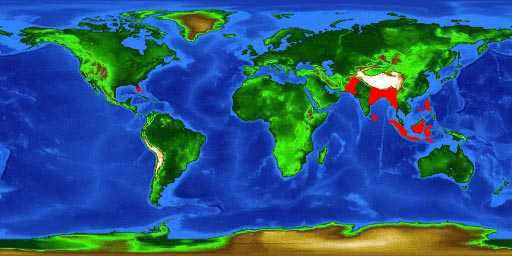
The walking catfish is a widely distributed species, known from Pakistan, eastern India, Sri Lanka (Ceylon), Bangladesh, Myanmar (Burma), Thailand, Malaysia, Singapore, Indonesia, and the Philippines. To what extent this distribution comprises the native range of the walking catfish is open to conjecture. Valued in aquaculture by some Southeast Asian peoples, it seems likely that human activities are responsible for the presence of the species in some of the more disjunct portions of its current range. In the United States, the history of the non-native population established in southern Florida during the early 1960’s is well documented. The spread of the walking catfish from one or perhaps two points of introduction encompassed 20 counties in approximately 10 years; effectively the entire southern peninsula of Florida.
Habitat
Walking catfishes are found in a wide variety of habitats including lakes and rivers but are best known for their ability to thrive where many fishes cannot. Warm, stagnant, often hypoxic waters such as muddy ponds, canals, ditches, swamps and flooded prairies are common habitat for this fish. Except for occasional forays to the surface for gulps of atmospheric air, this species spends most of its time on or near the substrate. Walking catfish are known to inhabit brackish waters and individuals from non-native populations in South Florida have been captured in Palm Beach County stretches of the intracoastal waterway.
Biology
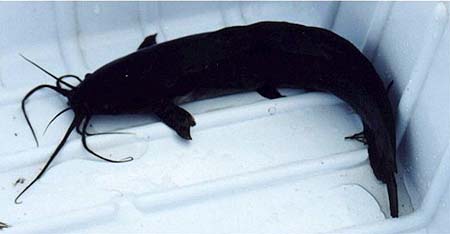
Distinctive Features
Walking catfish are typically a uniform shade of gray or gray-brown with many minute white spots laterally. The head is flat and broad and the body tapers to the tail in a manner that calls to mind the shape of a slender tadpole. The mouth is broad, although the gape is not great. The lips are fleshy, the upper more so than the lower. The walking catfish possesses very small eyes, a lengthy dorsal and anal fin that each terminate in a lobe near but free from the caudal fin, and pectoral fins with rigid spine-like elements, one each at the fore. It is through the use of these stiff pectoral “spines” accompanied by a back and forth flexion of the body that walking catfish accomplish their ungainly but effective terrestrial locomotion. The walking catfish may be easily distinguished from many of the North American Ictalurid catfishes in that the walking catfish lacks an adipose fin.
An internal feature of the walking catfish that is of considerable note with regard to its ability to traverse short stretches of land is the suprabranchial arborescent organ. An extension of the apparatus that supports the fish’s gill filaments, this structure facilitates the uptake of atmospheric oxygen by providing support for a number of gill filaments that would otherwise collapse in the absence of the buoyancy of water. In essence, this accessory air-breathing organ functions much like a lung. The branching appearance of this organ, reminiscent of a small tree, is the basis for the name “arborescent” organ.
Coloration
Although most individuals are gray or gray-brown with small white spots as described above, an albino was once popular with aquarists and calico morphs are known. Aberrantly colored walking catfish, conspicuous to predators, are uncommon in the wild.
Dentition
Numerous small pointed teeth occur in large bands on both the upper and lower jaw of the walking catfish. The arrangement of teeth is reported to vary somewhat in adults.
Size, Age, and Growth
Reproductively mature at one year of age, this species is reported to reach a length of 61cm (24 inches) in its native range, although the largest individuals in South Florida rarely exceed 36cm (14 inches). Overall, little is known regarding the age and growth of this species.
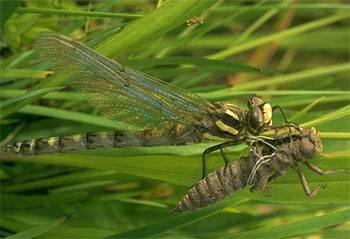
Food Habits
Walking catfish are benthic omnivores, industrious in their search for food. A nocturnal species, walking catfish search the bottom with their barbels vigorously sifting through detritus and soft substrates. A true generalist, walking catfish consume a wide variety of prey, including eggs or larvae of other fishes, small fishes, and a number of invertebrate taxa such as annelids, crustaceans, and insects. Given these somewhat indiscriminate feeding habits, it is not unusual to find a fair amount of detritus or plant matter in the gut this species. In densely populated drying pools, walking catfish are particularly indiscriminate in their choice of prey items, often seizing and consuming a wider variety of prey than what may normally be available.
Reproduction
Walking catfish construct nests made of detritus or submerged vegetation. The male guards the adhesive eggs and free-swimming young. In the native range of the walking catfish, spawning is coincident with the onset of the rainy season during which the species may construct nests in the flooded environs. A strong correlation between spawning and the wet season appears to be true for the non-native populations of walking catfishes in South Florida as well.
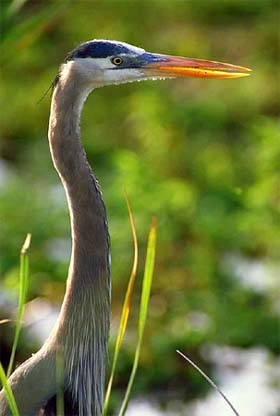
Predators
Walking catfish of all ages and size classes fall victim to a wide variety of predators including other fishes, reptiles, birds, and mammals. Wading birds are particularly adept at exploiting walking catfishes “stranded” in shallow drying pools and other evaporating water bodies. Introduced walking catfish in South Florida face at least one other source of mortality. From time to time, walking catfish may be seen migrating en masse from water body to water body, often traversing busy South Florida roads in the process. Such migrations take place most often on rainy nights, as the cool moist conditions reduce the risk of desiccation and abrasion. Nonetheless, scores of individual walking catfish are often killed during these movements by automobile traffic. Sections of roads such as U.S. 41 (Tamiami Trail) can actually become hazardously slick with the crushed bodies of walking catfish.
Parasites
Enteric septicemia of catfish or “ESC” has been reported for walking catfish. Caused by the bacteriumEdwardsiella ictaluri, this disease is of considerable concern to North American commercial catfish operations. Fortunately, most such operations are maintained outside the introduced range of the walking catfish, greatly reducing the possibility of wild walking catfishes infecting the farmed fishes, at least in North America.
Taxonomy
The walking catfish was formally described in 1758 as Silurus batrachus in Carolus Linnaeus’ 10th edition of Systema Naturae. Johannes Scopoli established the genus Clarias in 1777. Clarias is derived from Latin, meaning “shining”. Synonyms of Clarias batrachus include Macropteronotus fuscus Lacepède 1803, Macropteronotus jagur Hamilton 1822, Clarias assamensis Day 1877, and Clarias punctatus Valenciennes 1840. Members of the family Clariidae are collectively known as “air-breathing” catfishes although they are not the only catfish family capable of breathing atmospheric air.
Prepared by: Robert H. Robins